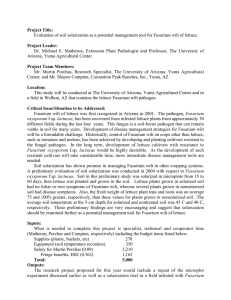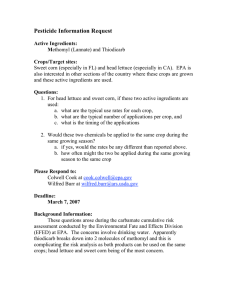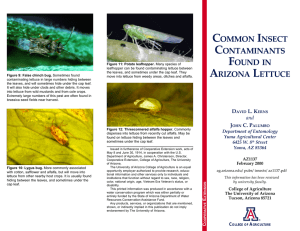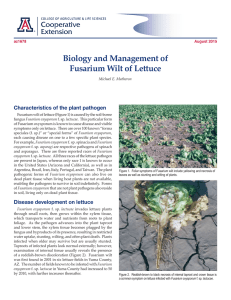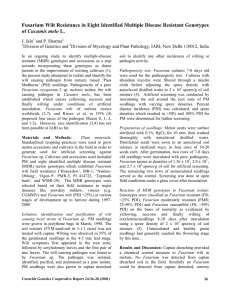A New Plant Disease Hits the U.S. “Winter Salad Bowl”
advertisement
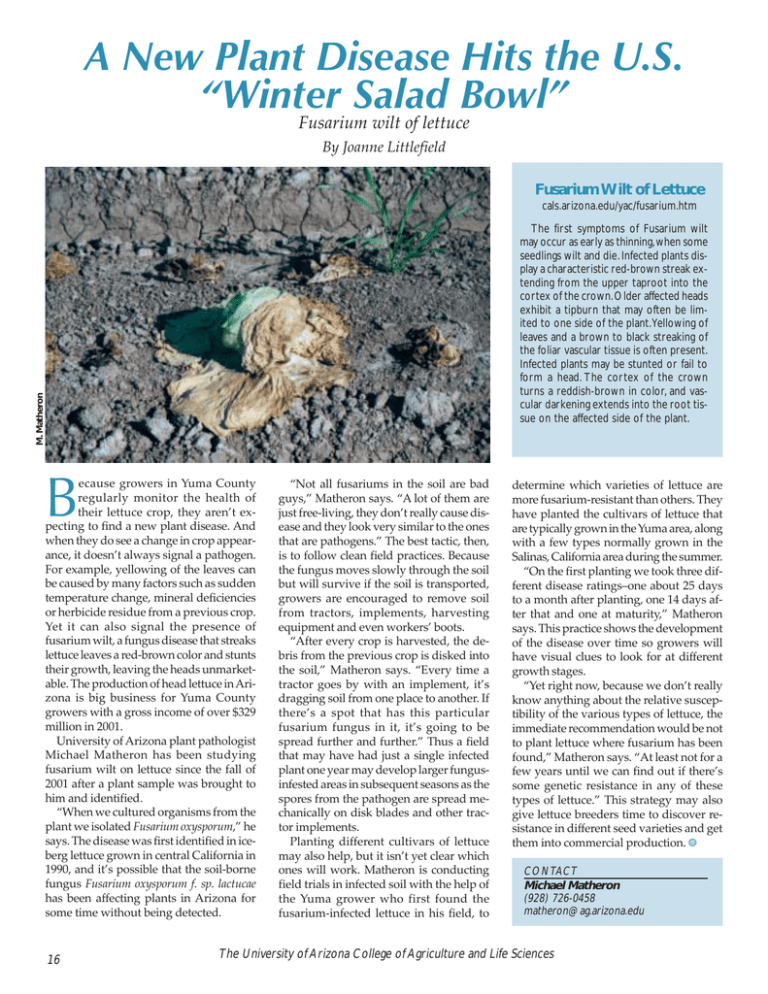
A New Plant Disease Hits the U.S. “Winter Salad Bowl” Fusarium wilt of lettuce By Joanne Littlefield Fusarium Wilt of Lettuce cals.arizona.edu/yac/fusarium.htm M. Matheron The first symptoms of Fusarium wilt may occur as early as thinning, when some seedlings wilt and die. Infected plants display a characteristic red-brown streak extending from the upper taproot into the cortex of the crown. Older affected heads exhibit a tipburn that may often be limited to one side of the plant. Yellowing of leaves and a brown to black streaking of the foliar vascular tissue is often present. Infected plants may be stunted or fail to form a head. The cortex of the crown turns a reddish-brown in color, and vascular darkening extends into the root tissue on the affected side of the plant. B ecause growers in Yuma County regularly monitor the health of their lettuce crop, they aren’t expecting to find a new plant disease. And when they do see a change in crop appearance, it doesn’t always signal a pathogen. For example, yellowing of the leaves can be caused by many factors such as sudden temperature change, mineral deficiencies or herbicide residue from a previous crop. Yet it can also signal the presence of fusarium wilt, a fungus disease that streaks lettuce leaves a red-brown color and stunts their growth, leaving the heads unmarketable. The production of head lettuce in Arizona is big business for Yuma County growers with a gross income of over $329 million in 2001. University of Arizona plant pathologist Michael Matheron has been studying fusarium wilt on lettuce since the fall of 2001 after a plant sample was brought to him and identified. “When we cultured organisms from the plant we isolated Fusarium oxysporum,” he says. The disease was first identified in iceberg lettuce grown in central California in 1990, and it’s possible that the soil-borne fungus Fusarium oxysporum f. sp. lactucae has been affecting plants in Arizona for some time without being detected. 16 “Not all fusariums in the soil are bad guys,” Matheron says. “A lot of them are just free-living, they don’t really cause disease and they look very similar to the ones that are pathogens.” The best tactic, then, is to follow clean field practices. Because the fungus moves slowly through the soil but will survive if the soil is transported, growers are encouraged to remove soil from tractors, implements, harvesting equipment and even workers’ boots. “After every crop is harvested, the debris from the previous crop is disked into the soil,” Matheron says. “Every time a tractor goes by with an implement, it’s dragging soil from one place to another. If there’s a spot that has this particular fusarium fungus in it, it’s going to be spread further and further.” Thus a field that may have had just a single infected plant one year may develop larger fungusinfested areas in subsequent seasons as the spores from the pathogen are spread mechanically on disk blades and other tractor implements. Planting different cultivars of lettuce may also help, but it isn’t yet clear which ones will work. Matheron is conducting field trials in infected soil with the help of the Yuma grower who first found the fusarium-infected lettuce in his field, to determine which varieties of lettuce are more fusarium-resistant than others. They have planted the cultivars of lettuce that are typically grown in the Yuma area, along with a few types normally grown in the Salinas, California area during the summer. “On the first planting we took three different disease ratings–one about 25 days to a month after planting, one 14 days after that and one at maturity,” Matheron says. This practice shows the development of the disease over time so growers will have visual clues to look for at different growth stages. “Yet right now, because we don’t really know anything about the relative susceptibility of the various types of lettuce, the immediate recommendation would be not to plant lettuce where fusarium has been found,” Matheron says. “At least not for a few years until we can find out if there’s some genetic resistance in any of these types of lettuce.” This strategy may also give lettuce breeders time to discover resistance in different seed varieties and get them into commercial production. CONTACT Michael Matheron (928) 726-0458 matheron@ag.arizona.edu The University of Arizona College of Agriculture and Life Sciences


